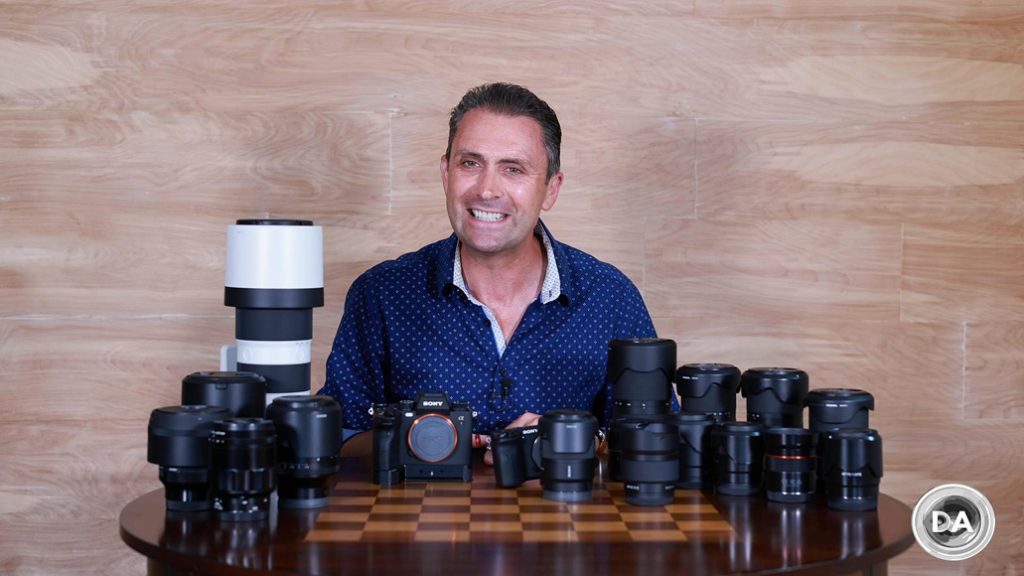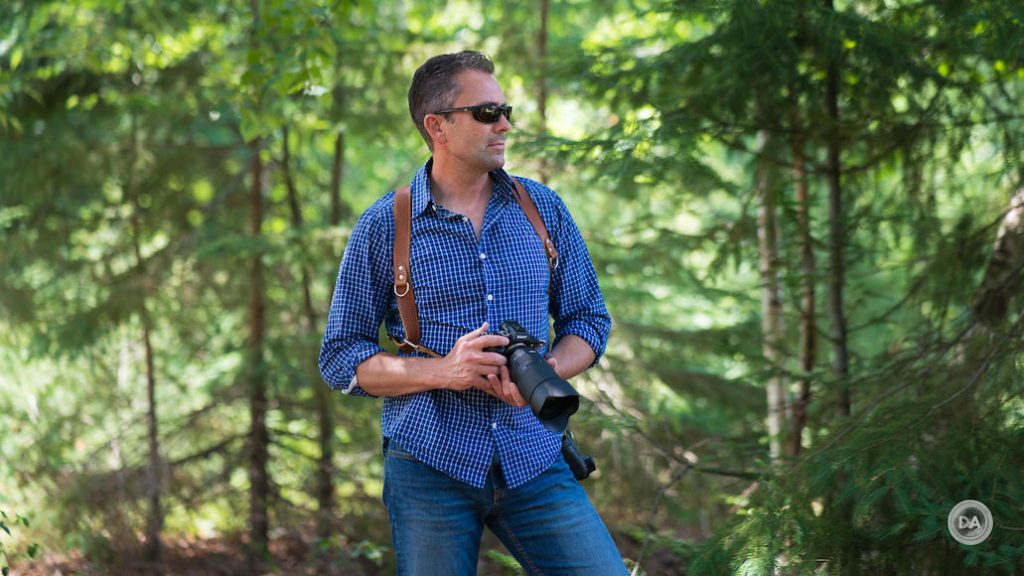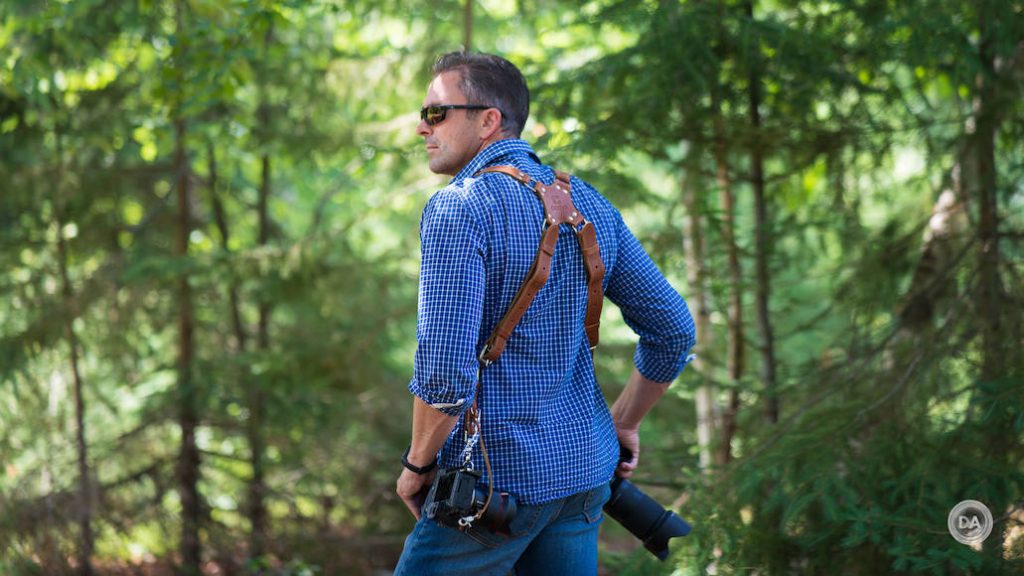



Dustin Abbott
Film Makers | Last Updated: February 28, 2023
My name is Dustin Abbott, and I run a successful YouTube channel that focuses on photography and photography gear-related tech reviews. Ironically, I originally had no interest in running a YouTube channel as I was doing text-based gear reviews on my website (dustinabbott.net).
At some point, I realized that I needed to illustrate a few points visually, and at the time, there wasn’t really a good mechanism for hosting videos directly on my website. So I started a YouTube channel in January of 2014 strictly for the purpose of hosting a four-minute video clip demonstrating the focus speed of a Tamron lens.
About two months later, I had an epiphany: I was already doing all of this work to create my text reviews, so why not leverage that knowledge into video reviews as well?
I did my first video review of the Canon EF 35mm f/2 IS at the end of March 2014 and didn’t post another video review until August of that year. That’s when things started moving forward, and I began to release a review with a tutorial video about once a week.
In the early stages, of course, views came slowly. My first big YouTube “payday” was ninety-three cents. That’s the tough stage, of course, when you are doing just as much work but getting very little recognition or remuneration for that work.
I could hardly get anyone to look at that first video review with less than one hundred views in the first week, but over time it has had over 115K views.
That’s a figure I would never have dreamed of in those early stages of frustration. You have to play the long game when trying to build something new.
I’ve been working through that whole process again in trying to build a new collaborative channel with my nephew (Let the Light In TV). Even with my extensive network today, building something new takes a lot of work and patience.
So if you are considering launching a channel just stick with it!
As a gear reviewer, I have somewhat different priorities than many photographers or filmmakers. My audience loves comparisons between a new piece of gear that I’m reviewing and some existing alternatives.
I keep a very extensive kit of cameras and lenses either to do tests on, to film with, or to have a point of comparison to new alternatives.
I also try to keep lenses from a variety of different lensmakers in order to be familiar with their products, to provide some points of comparison for new gear from that lensmaker, and to avoid the biases that can form when you become too attached to any one particular brand.
When you focus on more expensive gear, for example, you run the risk of being disconnected from the gear that more people from my audience can actually afford.
Anyway, I would probably end up boring everyone if I talked about every single piece of gear that I own and use, so I’ll share a representative selection.
Cameras
Sony Alpha 1 – this is probably my overall favorite camera and my primary test body for Sony E-mount gear. It essentially does everything well, and its superior focus and tracking capabilities make it a great body for testing those functions on lenses.
It has a 50MP resolution, making it an effective tool for testing lenses however it is on the expensive side.
Sony a7IV – this one costs about a third of the price of the Alpha 1, which makes it a far more relatable camera to many members of my audience.
I try to use and test lenses on both cameras, so my findings don’t end up biased by only using gear on Sony’s best. This is a great camera and one that I enjoy using. I also use it quite often for filming because it is easy and super reliable.
Sony a6400 – I use the a6400 as my primary test body for E-mount APS-C lenses. At this point, the 24MP sensor in the a6400 is the same as in more expensive cameras, and its focus system is just as good Plus, it is affordable for most people.
Canon EOS R5 – I really love the EOS R5 as a camera. Just like the Alpha 1, it is pretty much good at everything. It is probably my favorite camera in terms of its ergonomics, and it serves as my primary test body for Canon RF mount gear.
Canon EOS M5 – this is an older camera, and there probably isn’t a future for the EF-M mount now that Canon has started to release APS-C mirrorless cameras with an RF mount, but it has served as my test camera for EF-M mount lenses over recent years.
I also borrow Fujifilm cameras from Fujifilm Canada when I review either X-mount (APS-C) or GF-mount (Medium Format) Fuji gear.
Lenses
Sony G Master lenses – I tend to buy premium lenses for my own kit when they are superior to the competition.
I currently have two Sony G Master lenses in my personal kit – the 35mm F1.4 and 135mm F1.8 GM lenses. The former has a wonderfully compact design and great optics; the latter is one of the most superior optical instruments I’ve reviewed. I plan to add the Sony 50mm F1.2 GM lens to my kit this year.
Tamron zoom lenses – really intriguing lenses. I own three of them, including the premium 35-150mm F2-2.8 VXD, a fantastic zoom lens with an amazing focal length and brighter than typical maximum aperture. It’s my favorite overall zoom lens right now and the one I reach for most often for event settings.
I also own the Tamron 17-28mm F2.8 – a very competent and lightweight wide-angle zoom, and the Tamron 28-200mm F2.8-5.6 RXD that I use primarily for travel. It has a great focal range and surprisingly strong optical performance.
Sigma 85mm f/1.4 DN – this is an incredibly strong portrait prime lens with both beautiful bokeh and extremely sharp detail.
Samyang Prime lenses – Samyang has two separate tiers of lenses on Sony, and I like both of them. The first tier is their extremely compact “tiny” series that combine very small size with surprisingly strong optics.
I have the 24mm, 45mm, and 75mm F1.8 lenses in that series and use them all regularly for when I want to travel light. They also have a “pro” level series, and I currently use their 50mm F1.4 II and 135mm F1.8 lenses from that level.
Voigtlander 65mm f/2 APO Macro – this lens is only a 1:2 level macro and is manual focus only, but it has incredibly good optics and a wonderful manual focus ring. It’s my go-to lens for shooting product photography for my channel.
Sony 200-600mm G – my go-to long telephoto lens. It’s a bit large, but the internally zooming design is a joy to use once you’re on-site. The autofocus and optics are among the best I’ve seen in this class of lenses.
Canon L-series lenses – I have a couple of L-series lenses from Canon for my EOS R5, including one EF mount lens and the 35mm F1.4 II as Canon has not produced a high-end 35mm in the RF mount yet.
I also use the RF mount 24-105mm F4L because of the versatile focal length and acceptably good image quality. I have not invested in a lot of RF mount L series lenses as I find many of them to be overpriced, so I reach for Sony lenses instead.
Canon RF 50mm f/1.8 STM – this is a great value lens and a great size to bring along. This is arguably the best value lens on the RF platform and one that many people can afford.
Samyang primes – for a little while, it seemed like Samyang was really going to thrive on the RF mount system until Canon shut them down. This move on RF to be a closed platform is one that has really disappointed me.
Fortunately, both the Samyang AF 14mm F2.8 and 85mm F1.4 remain really competent options on my EOS R5 and are lenses I really enjoy using.
Laowa 90mm f/2.8 APO 2x Macro – this lens which I have in a Canon RF mount, is a killer for the macro that delivers a 2:1 level in an Apochromatic design. It is optically superior to most of the competition and is a lens I enjoy shooting with.
Irix 150mm f/2.8 Macro – this is one of the few EF mount lenses I have left in my kit so that I can use it on either my Canon or Sony cameras via an adapter. I’ve hung onto it because there are times when a longer focal length is useful for macro work, and the Irix offers a great combination of good build, good optics, and an affordable price point.
Lights
Rotolight AEOS and Neo lights – they are a powerful and versatile set of lights that can be used with either V-mount or AC power. They also have effects that are handy for a function.
GVM SD300D – a very powerful spotlight for those times when I need a LOT of light.
Genaray Crux lights – I also use some inexpensive round LED panels from Genaray on set. They can be easily powered via Sony F series type batteries, are flicker-free, and can be synced to control brightness and color temperature across multiple lights.
Godox Strobes – I like the Godox combination of price and performance, and have a number of Godox flash units, including some on-camera flashes (V1, V860II) and the AD series strobes (AD100, AD200, and AD300 units).
Mics
Hollyland Lark M1 – the Lark series is truly plug-and-play and is an easy, reliable way to get audio wirelessly to the camera for my “talking head” segments or interviews.
Hollyland Lark 150 – I’ll reach for the older Lark 150 if I actually need a lavalier mic attached.
Polsen MC-POD – a podcast mic that I have on a broadcast arm for my screen capture and at-computer sequences.
Bags/Straps
Peak Design Everyday – I use a lot of Peak Design bags and straps. They’re expensive but are very well made and have a lot of thoughtful engineering in their product lines.
Peak Design Slide Lite Straps – I prefer the Peak Design straps for several reasons. First is their anchor system, which makes it easy to attach or remove the strap quickly.
I like the integration with their Capture plates on my cameras, where I can attach a strap or go right to a tripod because of the Arca-compatible design.
Tripods
I use a few different tiers of tripods, depending on what I’m doing. My heavy-duty tripod is a Robus RC8860 Carbon Fiber Tripod and my primary lightweight tripod is the Peak Design Travel Carbon Fiber which is very expensive, but it is designed so well and is incredibly useful.
Hardware & Software
I primarily use Adobe’s Lightroom and Photoshop for my photo editing, along with some use of Exposure Software for the great presets.
I do most of my video editing in Cyberlink’s Director Suite along with some work in DaVinci Resolve. I started using Cyberlink’s PowerProducer a long time ago and got very comfortable with the interface, so I’ve never switched.
YouTube is a strange and wonderful place. When I started out, the idea that I could make money on YouTube almost seemed like a scam.
Sort of like, “Bill Gates will send you money if you pass on this email.” Whereas people of my generation (I’m in my mid-40s) might aspire to become movie stars, kids in school right now aspire to be “YouTubers.”
It’s often surprising (at least to me) what becomes a great success on YouTube…it’s an unpredictable place.
I’ve had some success there, but I recognize that it isn’t because I’m more talented than other people doing the same thing. I was blessed to connect with the right people and to develop a solid network of support.
I have had a lot of loyal viewers who have grown with me, and I’m very thankful for that.
The term the industry would use for someone like me is “Influencer.”
John Maxwell once said that “Leadership is influence. Plain and simple.” To be an influencer, by that definition, is to be a leader.
I like to think of influence as a bank account. You make deposits and withdrawals. Deposits are made by being trustworthy and honest, and withdrawals are made when I attempt to use my influence for some purpose.
I want to be very careful to use what influence I have wisely, so as a reviewer, I work very hard at being as balanced and objective as I can.
I don’t want to be viewed as a salesman (because I’m not); I want to be a leader, to use my unique access to new products as a means to help others make an informed decisions for themselves.
I would like to think that this mentality has helped me be successful.

Check out these 8 essential tools to help you succeed as a professional photographer.
Includes limited-time discounts.












